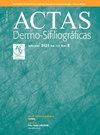[Translated article] Clinical–Epidemiological Profile, and Treatment Response in Relation to Associated Atopic Comorbidity in Atopic Dermatitis. Experience From the BIOBADATOP Registry
IF 3.8
Q1 DERMATOLOGY
引用次数: 0
Abstract
Background
Despite advances made in treatments for atopic dermatitis (AD), information on its impact and interaction with atopic comorbidities, such as asthma, rhinoconjunctivitis, and ocular disease is limited. This study aims to assess the clinical–epidemiological characteristics of patients with AD – treatment response included – while taking into consideration atopic comorbidities like these.
Materials and methods
Data were analyzed from the multicenter BIOBADATOP registry (a prospective cohort of AD patients initiating systemic treatment). We conducted a descriptive analysis of the main characteristics collected in the registry in relation to atopic comorbidity.
Results
We included a total of 509 patients, mostly adults (81.9%) with severe AD (73.7%). Patients with personal atopic comorbidity (64%) more frequently exhibited flexural dermatitis (89.7% vs. 81.5%), a higher mean of previous systemic treatments (1.6 vs. 1.3), and higher baseline values on the POEM scale (19.6 vs. 17.9). Patients with familial atopic comorbidity (40.7%) had a higher incidence of pediatric/adolescent patients (24.2% vs. 13.9%) and a history of allergic rhinoconjunctivitis (61.1% vs. 47.1%). No differences regarding treatment response were observed at the 6- and 12-month follow-ups based on the presence or absence of atopic comorbidities.
Conclusions
Results suggest that a history of atopic comorbidity is associated with an early onset and persistent course of AD. Although no differences were reported in the short-term treatment response, further follow-up is required to better understand the impact of comorbidities on AD.
[翻译]]特应性皮炎相关特应性共病的临床流行病学概况和治疗反应。来自BIOBADATOP注册表的经验。
背景:尽管特应性皮炎(AD)的治疗取得了进展,但有关其与特应性合并症(如哮喘、鼻结膜炎和眼部病理)的影响和相互作用的信息有限。本研究旨在评估AD患者的临床和流行病学特征,以及治疗反应,同时考虑到这些特应性合并症。材料和方法:数据分析来自多中心BIOBADATOP注册表,该注册表代表了开始全身治疗的AD患者的前瞻性队列。根据特应性合并症,对登记中收集的主要特征进行描述性分析。结果:共纳入509例患者,重度AD患者(73.7%)多为成人(81.9%)。具有个人特应性合并症的患者(64%)更频繁地出现屈曲性皮炎(89.7% vs. 81.5%),既往全身治疗的平均值更高(1.6 vs. 1.3), POEM量表的基线值更高(19.6 vs. 17.9)。家族性特应性合并症患者(40.7%)中,儿童/青少年患者(24.2%比13.9%)和过敏性鼻结膜炎病史(61.1%比47.1%)的发生率更高。在6个月和12个月时,根据是否存在特应性合并症,治疗反应没有差异。结论:结果表明,特应性合并症的历史表明AD的发病早,病程持续。虽然在短期治疗反应中没有观察到差异,但强调需要进一步随访以更好地了解合并症对AD的影响。
本文章由计算机程序翻译,如有差异,请以英文原文为准。
求助全文
约1分钟内获得全文
求助全文
来源期刊

Actas dermo-sifiliograficas
DERMATOLOGY-
CiteScore
1.90
自引率
9.40%
发文量
473
审稿时长
56 weeks
期刊介绍:
Actas Dermo-Sifiliográficas, publicación Oficial de la Academia Española de Dermatología y Venereología, es una revista de prestigio consolidado. Creada en 1909, es la revista mensual más antigua editada en España.En 2006 entró en Medline, y hoy resulta imprescindible para estar al día sobre la dermatología española y mundial.
 求助内容:
求助内容: 应助结果提醒方式:
应助结果提醒方式:


